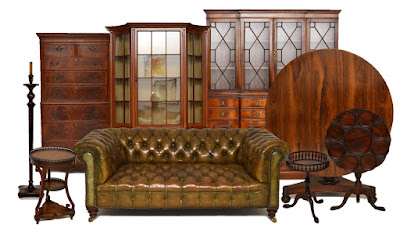What Makes An Antique Attractive to a Customer?
Guest Editor - Stuart Shuster, from Church Street Antiques

Stuart has owned and run Church Street Antiques, in Marylebone's famous antiques district in London for over 30 years, and specialises in Edwardian, Victorian, English, French, 17th - 20th century furniture. As a man in the antiques business for such a long period, Stuart has expertise of this business which exceeds his years, and thus his business has flourished. He has supplied items for the world's interior designers, celebrities and businessmen, and he knows how to sell his items. He's given us this article describing his approach to his stock selection, and what he thinks is important in a piece. He's very straight-forward in discussion, and he clearly knows his stuff - have a read on to hear the man himself.
The interesting thing about the antique business is that there are many different articles being sold at many different levels. Taking the furniture angle alone, there are many different levels at which it is being sold. In the future I will be giving you advice on different ways of finding, checking out & buying antique furniture, without having to over pay or get ripped off.
The kind of antique furniture I sell is basically affordable & functional. I'm not too bothered about datelines. The item doesn't have to be over 100 years old to be a good piece of furniture. For instance, some Victorian furniture can be very poorly made, whilst some 1950's pieces can be of amazing quality. You can buy a cheap quality inlaid mahogany Edwardian bureau bookcase for £750 or pay £1500 for a top quality 1950's example, which would be the one I would always buy.
 The value of both items might go up at a similar percentage, but the 50's bureau bookcase has got to be the better investment. To be honest, most items that I sell are at the common sense buying, price level. Just compare what you would have to pay for the modern day equivalent in the stores today. Not only would you pay more for the new equivalent, but it would be far inferior in quality, with a massive loss in value as soon as you purchase it. More importantly, it won't look as good, with no character & it certainly will not last as long.
The value of both items might go up at a similar percentage, but the 50's bureau bookcase has got to be the better investment. To be honest, most items that I sell are at the common sense buying, price level. Just compare what you would have to pay for the modern day equivalent in the stores today. Not only would you pay more for the new equivalent, but it would be far inferior in quality, with a massive loss in value as soon as you purchase it. More importantly, it won't look as good, with no character & it certainly will not last as long.
Most of the new furniture, being sold these days, is spray polished. That normally means that when scratched, the polish can just peal off & is difficult to polish over. I don't really want to get too technical right now, because I'd like to save that for another article in the future, regarding restoration & polishing. What I am really trying to say is, it's far better to buy the older piece of furniture, providing it's well made, than the new equivalent.
 The only cheap reproduction furniture available these days, is the nasty overseas spray polished imports from Far East countries. The main problem with these items is, besides being absolutely worthless as soon as they are purchased, the wood is never seasoned, so it starts splitting & warping in different room temperatures. Did you know that once the wood is cut from the tree, it needs to be left to dry out for many years, or be kiln dried; otherwise it will split & warp.
The only cheap reproduction furniture available these days, is the nasty overseas spray polished imports from Far East countries. The main problem with these items is, besides being absolutely worthless as soon as they are purchased, the wood is never seasoned, so it starts splitting & warping in different room temperatures. Did you know that once the wood is cut from the tree, it needs to be left to dry out for many years, or be kiln dried; otherwise it will split & warp.
The main point I am trying to make is, wherever possible, if you have the choice, steer away from new reproduction furniture, in favor of older equivalents. As long as they are over 40 years, the quality, character & resale value will be much better.
For Stuart's site, if you're searching for gorgeous Victorian furniture, especially large mahogany, oak, Burr walnut, leather pieces, Stuart has extensive and constantly-changing stock. Click here for his site:
http://www.churchstreetantiques.net/
http://www.churchstreetantiques.net/
For Stuart's Interior Boutiques page, for a selection of his items and to see his Boutique Shop, click here:
For more items, check out Interior Boutiques advance search:
http://interiorboutiques.com/Catalog/ShopByCategory
http://interiorboutiques.com/Catalog/ShopByCategory


No comments:
Post a Comment